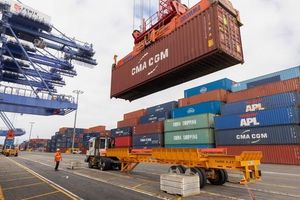On the eve of Thanksgiving, as kitchens across the United States fill with the sounds of frantic chopping, simmering, and last-minute recipe checks, one thing is certain: the demand for food delivery and grocery apps is about to hit its annual high. According to a recent report released by DoorDash on October 22, 2025, the day before Thanksgiving—this year falling on November 26—marks the busiest day of the year for the platform, with orders surging by nearly 90% compared to an average day. It’s a figure that speaks volumes about how Americans are embracing the convenience of technology to help navigate the chaos of holiday preparations.
DoorDash’s new Thanksgiving Trends Report paints a vivid picture: nearly 5 million orders are placed across the country on Thanksgiving Eve. The surge isn’t just about takeout cravings. Many users are turning to delivery apps to rescue them from forgotten ingredients or missing kitchen tools. In fact, the most popular last-minute purchases on Thanksgiving Day itself include meat thermometers, cake pans, and measuring cups—essential items for pulling off the perfect holiday meal. It’s a scenario familiar to anyone who’s realized, at the eleventh hour, that their famous stuffing can’t be made without that one critical ingredient. As 94.3 The Point humorously puts it, “Don’t worry, we’ve all been there!”
But what are people actually eating the night before the big feast? DoorDash’s data reveals that the most popular food delivery items on Thanksgiving Eve are comfort classics: cheeseburgers, tacos, chicken sandwiches, chicken wings, and chicken nuggets. It seems that with the stress of prepping for a house full of guests, many prefer to outsource dinner and save their culinary energy for the main event.
Yet while the convenience of food and grocery delivery apps is undeniable—especially when time is short and supermarket lines are long—consumers are paying a premium for that ease. According to a comprehensive investigation by Australian consumer advocacy group Choice, published on October 22, 2025, shoppers Down Under are seeing grocery costs soar when ordering through third-party apps like Uber Eats, DoorDash, and Milkrun. Their comparison of 13 common grocery items found that prices on these platforms averaged 11% higher than in-store, with delivery fees ranging from $5 to $11 pushing bills even higher.
For some, the price gap is even more dramatic. Choice found that, once delivery fees are included, baskets from Woolworths and Coles—two of Australia’s largest supermarket chains—cost 39% and 35% more, respectively, than if the same items were bought in person. Uber Eats emerged as the most expensive platform in the study. All Coles products cost more on Uber Eats and DoorDash than in-store, and seven out of 13 items at Aldi were pricier on DoorDash. Meanwhile, Milkrun, which Woolworths Group acquired in 2023, charged more for 11 out of 13 Woolworths items, despite sometimes offering a lower overall basket price than other delivery options.
Mark Serrels, editorial director at Choice, was blunt in his assessment: “I don’t think there should be a mark-up for the goods,” he told The Guardian Australia. “There should be a mark-up for the delivery itself. I don’t think anyone is saying that these companies shouldn’t charge to deliver your food [but] there’s absolutely no reason for you to pay more for bread just because someone’s delivering it.”
The platforms and supermarkets, for their part, point fingers at each other over who is responsible for the markups. A spokesperson from Uber told The Guardian Australia, “Each merchant selects the model that suits their needs and sets their own pricing on the platform – factoring in things like ingredient costs, supply chain pressures and day-to-day operating expenses. This flexibility ensures they can run their business on their terms.” Coles, meanwhile, explained, “Like most merchants, including retailers and restaurants, products sold through third-party delivery platforms such as Uber Eats and DoorDash are often a higher price point compared to shopping directly. This ensures that we can offer the service to our customers wanting instant delivery options (particularly when they are in a time-crunch).”
For shoppers looking to save, both Coles and Woolworths offer their own delivery services through their websites, with pricing much closer to what’s found in-store. Shopping directly from Coles online, for example, gives customers the same prices as in the physical store—even when factoring in a $15 delivery fee, it’s still cheaper than using a third-party app, according to Choice’s findings. Woolworths’ Milkrun service, which promises 35-minute delivery, is priced differently due to the “level of convenience offered,” a spokesperson said, but all prices and fees are clearly disclosed up front.
In an interesting twist, Aldi, the German discount supermarket chain, began trialing delivery through DoorDash in Canberra in July 2025 before rolling out the service nationally in September. During the initial trial, The Guardian Australia found that the additional costs of ordering Aldi groceries via DoorDash meant the chain was no longer significantly cheaper than its rivals. Choice’s quarterly supermarket price surveys confirm that Aldi’s price advantage is mostly in packaged and ready-to-eat foods, with only a small edge when it comes to fresh fruit and vegetables.
DoorDash, for its part, argues that the impact of delivery fees is less significant for larger orders. “The average Aldi customer buys around more than 20 items per shop on DoorDash, meaning that delivery-related fees make up a far smaller share of the total order,” a company spokesperson said. “When looked at through that lens, the overall difference in cost is significantly less than the figure being quoted. DoorDash works to ensure that every customer can see item pricing and any applicable fees before checkout, so they understand exactly what they are paying for.” Aldi, meanwhile, insists it remains “committed to delivering the best value to our shoppers and that extends to DoorDash. While there is a cost to convenience, many everyday essentials match our in-store prices.”
The debate over convenience versus cost isn’t limited to groceries. As millions of Americans prepare for Thanksgiving, the trade-off is clear: whether it’s a last-minute meat thermometer or a cheeseburger to fuel a night of prep, the price of saving time is higher than ever. Complex pricing structures—sometimes described as “convoluted” by consumer advocates—make it all too easy for shoppers to pay more than they realize. As Serrels put it, “The more convoluted the pricing the more likely someone is to pay more than they should. So I don’t think that’s by accident.”
As the holiday season approaches and delivery apps brace for another record-breaking night, the message for consumers is simple: convenience comes at a cost. For some, the trade-off is worth it—especially when the alternative is battling supermarket crowds on Thanksgiving Eve. For others, a little planning ahead could mean big savings, leaving more to spend on what really matters: sharing a delicious meal with friends and family.




